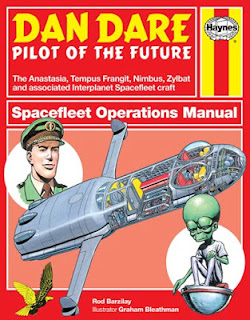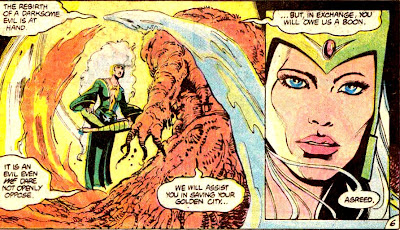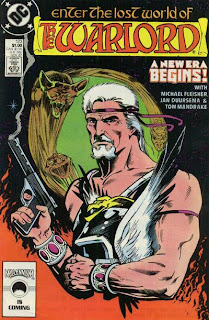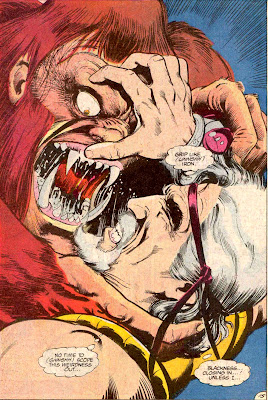Warlord #127 (March 1988)
Written by Michael Fleisher; Pencils by Jan Duursema, Inks by Tom Mandrake
Synopsis: Believing Tara dead, Morgan has left Shamballah and returned to wandering. After an encounter with a smilodon, followed immediately by an attack by a pack of raptors, Morgan is saved by a masked bowman named Dreadnar. Morgan loses his horse to the raptors, but decides to travel with Dreadnar for a bit.
Meanwhile, Khnathaiti is hiding from Skartaris’s eternal sun in a cave beneath the volcano. Her powers have diminished since the death of the Scavenger, but she manages to suck the life force of a rat to stave off decay. She swears vengeance on the Warlord who reduced her to this.
After acquiring some now horses, Dreadnar leads Morgan to the Vale of the Dragon. Here his people lived for a thousand years, worshipping the dragons that dwelt there and sometimes appeasing them with sacrifices of “unblemished maidens.” One year, the shamans withheld the sacrifice due to a famine, and the dragons attacked. Dreadnar and his elder son returned to the village to find it destroyed.
The two went on a rampage of revenge against the beasts, killing all but one: a female, with eggs. She ambushed them, killing Dreadnar’s son in a blast of fire. Dreadnar escaped with his life, but:
Morgan and Dreadnar come upon some scroungers digging around the remains of Dreadnar’s old village looking for valuables. Dreadnar routs them and would have killed their leader, but Morgan convinces him the rat isn’t worth it. The scoundrels haven’t gotten far when they’re roasted by dragon fire. Morgan and Dreadnar run for it and dive into a nearby lake for protection.
When they come up for air, it seems the danger may have passed. When again:
In the Siberian gulag, an old enemy of Morgan’s, Danny Maddox, watches Mariah be dragged off to be punished after standing up to the sadistic guards. She’s stuck in an unheated cell with no food. Maddox gives her a little gift:
Things to Notice:
- Shakira gets big hair in this issue.
- While it isn't the first time, the dragon in this issue is a "fantasy dragon" rather than a dinosaur like in previous issues.
Where It Comes From:
This issue shares a title with a 1985 film, but there really isn't a relationship between the two.
Danny Maddox first appeared as a young bully in Travis Morgan's hometown back in issue #91. Fleisher brought him back and gave him many more run-ins with Morgan over the course of their lives as depicted in Secret Origins #16 (July 1987), which seems to set-up his appearance here.
This issue shares a title with a 1985 film, but there really isn't a relationship between the two.
Danny Maddox first appeared as a young bully in Travis Morgan's hometown back in issue #91. Fleisher brought him back and gave him many more run-ins with Morgan over the course of their lives as depicted in Secret Origins #16 (July 1987), which seems to set-up his appearance here.



























































